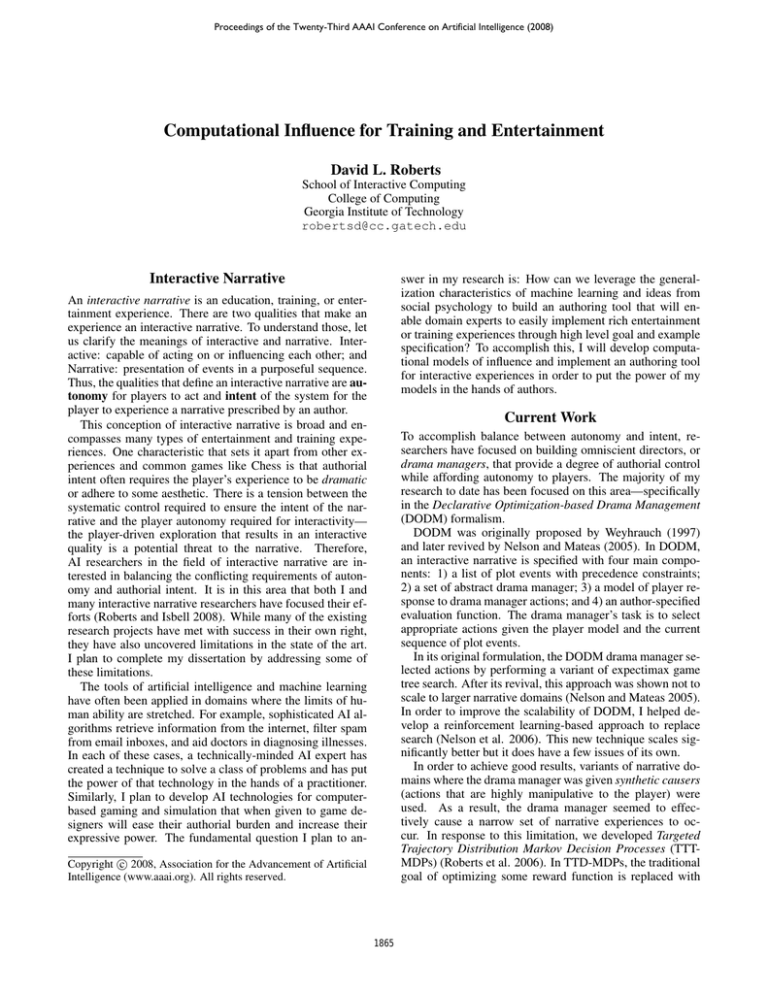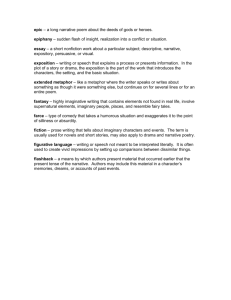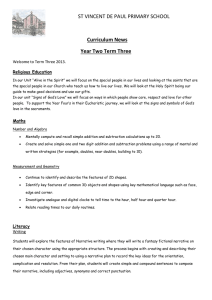
Proceedings of the Twenty-Third AAAI Conference on Artificial Intelligence (2008)
Computational Influence for Training and Entertainment
David L. Roberts
School of Interactive Computing
College of Computing
Georgia Institute of Technology
robertsd@cc.gatech.edu
Interactive Narrative
swer in my research is: How can we leverage the generalization characteristics of machine learning and ideas from
social psychology to build an authoring tool that will enable domain experts to easily implement rich entertainment
or training experiences through high level goal and example
specification? To accomplish this, I will develop computational models of influence and implement an authoring tool
for interactive experiences in order to put the power of my
models in the hands of authors.
An interactive narrative is an education, training, or entertainment experience. There are two qualities that make an
experience an interactive narrative. To understand those, let
us clarify the meanings of interactive and narrative. Interactive: capable of acting on or influencing each other; and
Narrative: presentation of events in a purposeful sequence.
Thus, the qualities that define an interactive narrative are autonomy for players to act and intent of the system for the
player to experience a narrative prescribed by an author.
This conception of interactive narrative is broad and encompasses many types of entertainment and training experiences. One characteristic that sets it apart from other experiences and common games like Chess is that authorial
intent often requires the player’s experience to be dramatic
or adhere to some aesthetic. There is a tension between the
systematic control required to ensure the intent of the narrative and the player autonomy required for interactivity—
the player-driven exploration that results in an interactive
quality is a potential threat to the narrative. Therefore,
AI researchers in the field of interactive narrative are interested in balancing the conflicting requirements of autonomy and authorial intent. It is in this area that both I and
many interactive narrative researchers have focused their efforts (Roberts and Isbell 2008). While many of the existing
research projects have met with success in their own right,
they have also uncovered limitations in the state of the art.
I plan to complete my dissertation by addressing some of
these limitations.
The tools of artificial intelligence and machine learning
have often been applied in domains where the limits of human ability are stretched. For example, sophisticated AI algorithms retrieve information from the internet, filter spam
from email inboxes, and aid doctors in diagnosing illnesses.
In each of these cases, a technically-minded AI expert has
created a technique to solve a class of problems and has put
the power of that technology in the hands of a practitioner.
Similarly, I plan to develop AI technologies for computerbased gaming and simulation that when given to game designers will ease their authorial burden and increase their
expressive power. The fundamental question I plan to an-
Current Work
To accomplish balance between autonomy and intent, researchers have focused on building omniscient directors, or
drama managers, that provide a degree of authorial control
while affording autonomy to players. The majority of my
research to date has been focused on this area—specifically
in the Declarative Optimization-based Drama Management
(DODM) formalism.
DODM was originally proposed by Weyhrauch (1997)
and later revived by Nelson and Mateas (2005). In DODM,
an interactive narrative is specified with four main components: 1) a list of plot events with precedence constraints;
2) a set of abstract drama manager; 3) a model of player response to drama manager actions; and 4) an author-specified
evaluation function. The drama manager’s task is to select
appropriate actions given the player model and the current
sequence of plot events.
In its original formulation, the DODM drama manager selected actions by performing a variant of expectimax game
tree search. After its revival, this approach was shown not to
scale to larger narrative domains (Nelson and Mateas 2005).
In order to improve the scalability of DODM, I helped develop a reinforcement learning-based approach to replace
search (Nelson et al. 2006). This new technique scales significantly better but it does have a few issues of its own.
In order to achieve good results, variants of narrative domains where the drama manager was given synthetic causers
(actions that are highly manipulative to the player) were
used. As a result, the drama manager seemed to effectively cause a narrow set of narrative experiences to occur. In response to this limitation, we developed Targeted
Trajectory Distribution Markov Decision Processes (TTTMDPs) (Roberts et al. 2006). In TTD-MDPs, the traditional
goal of optimizing some reward function is replaced with
c 2008, Association for the Advancement of Artificial
Copyright Intelligence (www.aaai.org). All rights reserved.
1865
To enable non-technical authors to take advantage of these
algorithms, I will build a library and example-based authoring tool that will translate high-level narrative goals into
concrete implementations using click-whirr scenarios. In
conclusion, by developing algorithmic models of persuasion
for interactive narratives, providing a design tool to easily
implement them, and evaluating that tool, I will address the
criticisms of DODM by obtaining concrete results for the
formalism, verifying an author’s abilities to use DODM, and
increasing a player’s perceived autonomy.
the goal of minimizing divergence from a target distribution
over experiences—the traditional notion of optimality may
be sacrificed during any single episode to achieve optimality
during repeated play.
Since then, there have been a number of efforts furthering
the DODM formalism and TTD-MDPs. First, we developed
a provably optimal algorithm for solving TTD-MDPs (Bhat
et al. 2007). We have also applied the DODM framework
and TTD-MDPs to guiding visitors in a museum (Roberts,
Cantino, and Isbell 2007). Along slightly different lines, we
have developed a technique to estimate from observations
the player’s satisfaction resulting from the use of a DODMbased drama manager (Roberts, Strong, and Isbell 2007).
Lastly, we have developed an approach to authoring target
distributions for TTD-MDPs that has very nice computational properties and we believe is more intuitive (Roberts
et al. 2007).
References
Bhat, S.; Roberts, D. L.; Nelson, M. J.; Isbell, C. L.; and
Mateas, M. 2007. A globally optimal algorithm for ttdmdps. In Proceedings of the Sixth International Joint Conference on Autonomous Agents and Multiagent Systems
(AAMAS07).
Cialdini, R. B. 1998. Influence: The Psychology of Persuasion. Collins.
Nelson, M. J., and Mateas, M. 2005. Search-based drama
management in the interactive fiction anchorhead. In Proc.
of the 1st AI and Interactive Digital Entertainment Conf.
Nelson, M. J., and Mateas, M. 2008. Another look at
search-based drama management. In Proc. of the 7th Int.
Joint Conf. on Autonomous Agents and Multiagent Systems.
Nelson, M. J.; Roberts, D. L.; Isbell, C. L.; and Mateas, M.
2006. Reinforcement learning for declarative optimizationbased drama management. In Proceedings of the Fifth International Joint Conference on Autonomous Agents and
Multiagent Systems (AAMAS06).
Roberts, D. L., and Isbell, C. L. 2008. A survey and qualitative analysis of recent advances in drama management.
International Transactions on Systems Science and Applications, Special Issue on Agent Based Systems for Human
Learning. To appear.
Roberts, D. L.; Nelson, M. J.; Isbell, C. L.; Mates, M.; and
Littman, M. L. 2006. Targeting specific distributions of
trajectories in mdps. In Proceedings of the 21st National
Conference on Artificial Intelligence (AAAI-06).
Roberts, D. L.; Bhat, S.; Clair, K. S.; and Isbell, C. L.
2007. Authorial idioms for target distributions in ttd-mdps.
In Proceedings of the 22st Conference on Artificial Intelligence (AAAI-07).
Roberts, D. L.; Cantino, A. S.; and Isbell, C. L. 2007.
Player autonomy versus designer intent: A case study of
interactive tour guides. In Proceedings of the Third Conference and Artificial Intelligence for Interactive Digital Entertainment (AIIDE-07).
Roberts, D. L.; Strong, C. R.; and Isbell, C. L. 2007. Estimating player satisfaction through the author’s eyes. In
Proceedings of the Second Workshop on Optimizing Player
Satisfaction.
Weyhrauch, P. 1997. Guiding Interactive Drama. Ph.D.
Dissertation, School of CS, CMU, Pittsburgh, PA. Tech
Rept CMU-CS-97-109.
Future Work
There have been three main criticisms of the DODM framework and TTD-MDPs: 1) DODM is abstract, divorced from
concrete implementation and most of its results have been
in simulation; 2) It remains to be verified that game authors
can take advantage of DODM; and 3) Some feel TTD-MDPs
provide variety of experience at the cost of player autonomy (Nelson and Mateas 2008). My dissertation will address all three of these concerns. In doing so, I will provide
tools that enable authors of interactive narratives to create increasingly complex and engaging scenarios without increasing their burden. Progress toward this goal will enable domain experts—rather than technical experts—to leverage the
power of DODM for creating interactive narratives and increase their potential to author complex and realistic content.
Computer scientists have developed powerful and widelyused algorithms by making analogies to naturally-occurring
processes such as insect swarming behavior, evolution (leading to genetic algorithms/programming), hill climbing for
optimization, or neural processes in artificial neural networks. Similarly, I will use the analogies of human behavior patterns identified in social psychology to develop tools
for interactive narrative. I will develop a paradigm based
on the ideas of influence and persuasion. By abandoning
approaches based on prevention which can cause players to
feel coerced and require complicated hand authored behavior models, I will enhance both the player’s experience by
convincing them that they are making their own decisions
and the author’s experience by reducing their authoring burden. To accomplish this, I will develop computational models of persuasion.
The field of social psychology has identified numerous
click-whirr responses which function as pre-programmed
behavioral responses to common social situations (Cialdini
1998). In humans, these responses appear to help us cope
with the increasingly overwhelming daily stimuli that we
process. A key aspect of these responses is that people believe they are making a choice by their own free will when
their choice is, in effect, all but pre-determined.
By modeling persuasion, I will provide authors with powerful algorithmic tools for constructing engaging narratives.
1866




